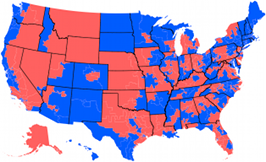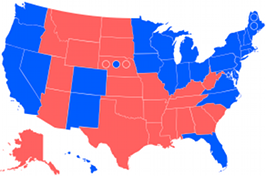If we look at a series of five polls of the Wisconsin Senate matchup between Senator Russ Feingold, Democrat, and former Governor Tommy Thompson, Republican, we find a broad range of results.
On no news can we really expect the race to move 16 points in one week? Some of these have to be wrong, but will we ever know which?
[More]
Rasmussen Reports has a new Nevada Senate poll out, and the results are looking terrible for Harry Reid. The Democrat is looking likely to be the second consecutive incumbent floor leader for his party to be voted out of office.
Conventional wisdom says incumbents below 50 are vulnerable. Well, two of the three Republicans running to replace him are now above 50, and the third is at 49.
[More]
USC and the LA Times polled some of the major California statewide races. The results, provided by pollsters Greenberg Quinlan Rosner and American Viewpoint, seem generally in line with what we’ve seen so far: Campbell and Fiorina are in a close primary race, lagged by DeVore. Boxer can’t reach 50. Whitman cruises in the primary.
The big news to my eye is that Jerry Brown has fallen behind.
[More]
It’s late; I spent a lot of time preparing my nationwide modeling software, but here’s a quick look at the Arkansas Senate race, per Rasmussen. It’s a mess.
[More]
Rasmussen Reports has a new one on the Ohio Governor’s race. Kasich 46, Strickland 45, MoE 4.5. 54% chance Kasich is ahead according to my model, down from the 80s a couple of weeks ago.
This is more consistent with the previous trend and seems to confirm the RealClearPolitics theory that Quinnipiac has a few points of bias toward the Democrats in Ohio polling.
Quinnipiac University released a new poll on the Ohio Governor’s race that has caused a stir. It shows Governor Ted Strickland, Democrat, ahead of former Congressman John Kasich, Republican, while previous polling showed the reverse.
The swing is large at first glance. Should Ohio Democrats be excited? Should Ohio Republicans panic? Let’s unpack this.
[More]
Also by request I’ve taken a look at the Florida special election coming up next month for District 19, filling in the seat vacated by Robert Wexler.
Sadly I can find no polling for this (special) general election race. Given that Wexler’s closest race was his first one in 1996 when he beat the Republican 66-34, and additionally this is in the part of the state most friendly to Democrats, pollsters just don’t expect this race to be close.
[More]
By request I’ve looked up the race in Indiana’s 9th District, which appears like it’s going to be a fourth rematch between former Rep. Mike Sodrel and Rep. Baron Hill. Hill voted for the PPACA, so national Republicans are sure to target him in this usually-Republican state that barely went for President Obama in 2008.
[More]
In the possible rematch in Michigan’s 7th Congressional District, there seems to be no independent polling yet. By request I looked for polls on this race, but for the budding 2010 matchup of Tim Walberg and Mark Schauer all I find is one internal poll.
Walberg’s is good for him showing 46 R/37 D/5.6 MoE for a 78% win rate for the Republican. I expect real polling only after the primary for a race like this.
On the heels of a Rasmussen poll suggesting Democrats should worry about Senator Barbara Boxer’s re-election chances, comes worse news from Field for the three term incumbent.
The raw numbers: Campbell 44/Boxer 43, Fiorina 44/Boxer 45, DeVore 41/Boxer 45, 3.7% Margin of Error. My model’s win percentages: DeVore 29%, Fiorina 44%, and Campbell 55%.
[More]
The California Republican primary race to determine Barbara Boxer’s challenger is getting heated. And while all of us in the state have our biases and preferences, here’s what my cold, hard math says about Rasmussen’s latest poll.
[More]
While playing around with primary polling lets me practice how I look at an individual poll, it does nothing for my work on aggregating polls and creating national projections.
So if I can get the historical election week polling data I expect to start doing some backtesting over the spring and early summer. I’ll come up with models and test them by “projecting” past House elections, Senate elections, and Presidential elections.
Whichever model works best I will use to project the 2010 midterms. Additionally I’ll learn which pollsters are better than others, which will only improve my projections.
Today I use a poll of a primary race between two Democrats to illustrate my initial model of a horserace election poll. Until the general election season begins in earnest, the primaries are all we have and I intend to use them as a warmup.
[More]


 House of Representatives Swingometer
House of Representatives Swingometer Electoral College Swingometer
Electoral College Swingometer